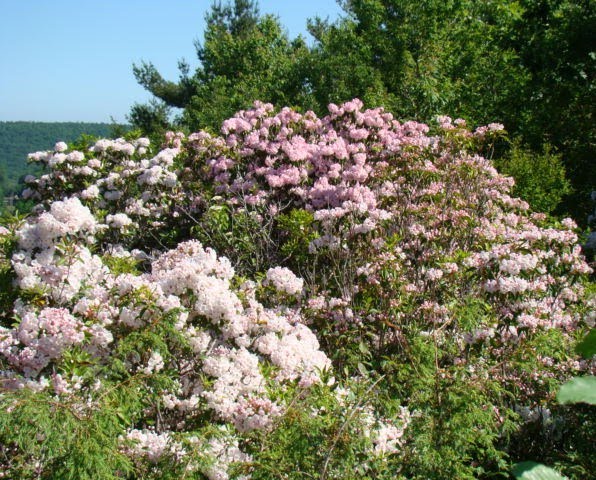
General Information
Mountain Laurel is a large evergreen shrub or small tree with leathery pointed leaves. It is found in eastern portions of the United States, from Maine to Florida extending west to Indiana, Kentucky, Mississippi, and Louisiana. It is common in the Appalachian Mountains and along coastal plains from Maine to Florida. Its North American range extends into southern Quebec. It is an understory species found in a variety of forests and growing among numerous plant species.

Plant Habit and Form
Mountain Laurel is a hardy shrub of variable size ranging from 7 to 15 feet, growing as large as 25 feet along the southeastern U.S. Piedmont range where they grow in dense thickets. It has many twisting branches, often becoming straggly and more open in mature plants. The leaves are glossy dark green above and yellowish green underneath, elliptical to lanceolate in form, and 2 to 5 inches long. Mountain Laurel is monoecious with 1-inch bowl shape flowers, varying from white to rose with purple markings, appearing in late spring and early summer. The bark is thin and gray-brown, with splitting and shredding on older branches.
Growing Requirements
Mountain Laurel requires acidic, cool, moist, well-drained soils. It grows in sun or shade, flowering best in sunnier locations. It is hardy to zone 5 (with protection in zone 4).
Flowering and Fruiting
Flowers are quite showy, appearing in late May and June, and occur in 4 to 6 inch clusters. The blooms start out pink and open to white with purple markings. They are followed by brown fruit capsules that remain on the plant through winter.
Pests and Diseases
Mountain Laurel is susceptible to leaf spot, lacebug, white fly and scale.
ID Tips
Large shrubs with broad evergreen leaves elliptically shaped with pointed tips, whorls of showy pink to white flowers followed by persisting fruit clusters held upright.

